With over 85 thousand different types of plastic injection molding materials to choose from, it can be overwhelming for designers and entrepreneurs. Selecting the material for plastic injection mold manufacturing ensures your product’s quality and function.
Assess your specific strength, flexibility, chemical resistance requirements, and more. Consider aesthetics as well since the look of your product is an essential factor.
Material Requirements
There are many factors to consider when selecting suitable materials for plastic injection molding. First, evaluate your product requirements. Consider the material’s strength, chemical resistance, and ability to withstand mechanical impact. Also, consider whether the material needs to meet industry standards or regulations, such as food safety or medical-grade standards.
Next, determine the cost. This includes the initial price of the material and the cost of production, labor, and tooling. Ensure that the material you select matches your budget and can provide value over the life of your product.
When choosing materials for plastic injection molds manufacturing, evaluating their shrinkage rate is essential. This factor can help you save on costs by avoiding the need for expensive redesigns to accommodate increased wall thickness. Also, select a material with uniform wall thickness to prevent warping or twisting during cooling. This can be caused by thick sections cooling faster than thin ones, which leads to stress concentrations and dimensional changes.
Aesthetics
Aside from ensuring the product function you require, it’s also important to consider aesthetics and durability when selecting suitable plastic materials for injection molding. Consider factors like whether you want your finished product to be opaque or transparent or if it needs to withstand high temperatures. Evaluate your plastic part’s expected lifespan and environmental conditions, which may influence its material requirements.
Injection molding materials come in various choices, from inexpensive, commonly used plastics to higher-cost engineering-grade resins. Selecting a material that meets your functional and visual requirements is the first step in achieving a successful product. Understanding how your preferred plastic responds to challenges like shrinkage and warping is also essential. To mitigate these issues, opt for a material with predictable shrinkage rates and choose a mold with uniform wall thickness. This ensures that the molten plastic cools and solidifies evenly, minimizing distortion.
Durability
If a plastic injection mold has to endure rigorous usage, then durability is a vital consideration. Choosing suitable materials ensures the final product is robust enough to meet its intended function.
For example, if a plastic cart needs to hold up to the wear and tear of toddlers, then the material should be durable enough to resist cracks and abrasions. Other factors that influence durability include the wall thickness and complexity of a plastic molded part and the material’s rate.
The type of steel alloy used in a plastic injection mold can significantly influence its lifespan. For instance, pre-hardened steel such as 718 offers excellent machinability and can withstand high temperatures.
Sustainability
Injection molding can play a significant role in the sustainability conversation. The manufacturing process of reducing waste, time, and costs and maintaining optimal quality aligns with core values that drive sustainability initiatives like Design for Manufacturing (DfM).
Choosing eco-friendly plastic resins is another way to make your products more sustainable. These plant-based materials reduce your company’s reliance on non-renewable resources and lower carbon emissions during production.
Sustainable resins may have different properties than traditional ones, so conducting comprehensive material compatibility testing is essential before you start working with them. This will ensure your new materials work seamlessly with existing molds and processes.
Plastic manufacturers should also seek out energy-efficient equipment and consider using alternative fillers made from natural substances like coconut shells or rice hulls to reduce the amount of virgin material needed for the product. In addition, companies should consider how their plastics will be recycled or biodegraded at the end of their lifespan.

